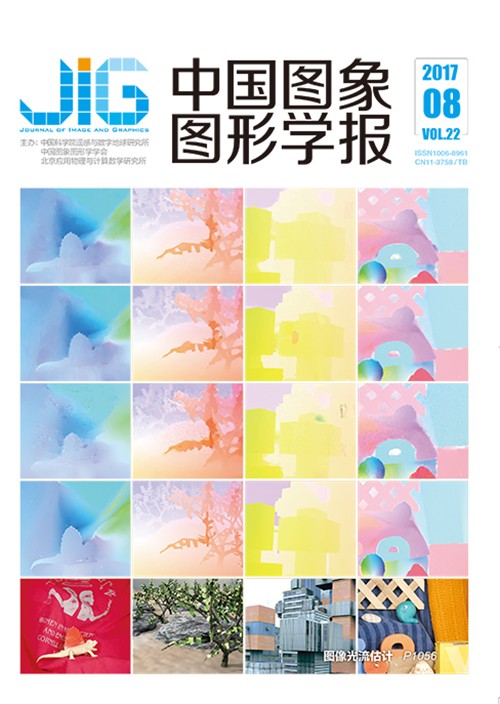
颅骨点云模型的局部特征配准方法
赵夫群1,2, 周明全2,3, 耿国华2(1.咸阳师范学院教育科学学院, 咸阳 712000;2.西北大学信息科学与技术学院, 西安 710127;3.北京师范大学信息科学与技术学院, 北京 100875) 摘 要
目的 点云配准是计算机视觉领域里的一个研究热点,其应用领域涉及3维重建、目标识别、颅面复原等多个方面。颅骨配准是颅面复原的一个重要步骤,其配准的正确与否将直接影响到颅面复原的结果。为了提高颅骨配准的精度和收敛速度,提出一种基于局部特征的颅骨点云模型配准方法。方法 首先提取颅骨点云模型的局部深度、法线偏角和点云密度等局部特征;然后计算局部特征点集的相关性,得到相关候选点集,并通过删减外点实现颅骨点云的粗配准;最后采用基于高斯概率模型和动态迭代系数的改进迭代最近点 (ICP) 算法实现颅骨的细配准。结果 通过对公共点云数据模型以及颅骨点云数据模型分别进行配准实验,结果表明,基于局部特征的点云配准算法可以完成点云模型的精确配准,特别是对颅骨点云模型具有较好的配准效果。在颅骨细配准阶段,跟ICP算法相比,改进ICP算法的配准精度和收敛速度分别提高了约30%和60%;跟概率迭代最近点 (PCP) 算法相比,其配准精度差异不大,收敛速度提高了约50%。结论 基于局部特征的点云配准算法不仅可以用于公共点云数据模型的精确配准,而且更适用于颅骨点云数据模型的配准,是一种精度高、速度快的颅骨点云模型配准方法。
关键词
Local feature registration method of skull point cloud model
Zhao Fuqun1,2, Zhou Mingquan2,3, Geng Guohua2(1.College of Education Science, Xianyang Normal University, Xianyang 712000, China;2.College of Information Science and Technology, Northwest University, Xi'an 710127, China;3.College of Information Science and Technology, Beijing Normal University, Beijing 100875, China) Abstract
Objective Point cloud registration with numerous applications, including 3D modeling, object recognition, scene understanding, 3D shape detection, and craniofacial reconstruction, is a significant and active research topic in computer vision.A 3D scanner can only obtain the partial 3D point cloud of one object associated with a single coordinate system from one viewpoint.The 3D point clouds captured from different viewpoints must be transformed into a common coordinate system according to rigid transformations to reconstruct the overall 3D shape.The 3D point cloud registration aims to compute the rigid transformation between 3D point clouds and automatically obtain the complete 3D shape of the object.Skull registration is an important step in craniofacial reconstruction.The correctness of its registration will directly affect the result of craniofacial reconstruction.Skull registration is the process of searching for one or more reference skulls from the existing skull database that is most similar to an unknown skull.The face of the reference skull can be used as the reference face of the unknown skull to provide a possible basis for craniofacial reconstruction.Thus far, most of the skull registration methods are feature-based method that contains two methods, namely, global and local feature-based methods.The extraction of feature descriptors is extremely important for registration.The global feature descriptor performs excellent discrimination for complete object representation, whereas the local feature descriptor is more robust against noise and outliers.The local feature descriptor is more suitable for the skull model registration than the global feature descriptor because of the complexity of skull point cloud model.Among the local feature descriptors, 3D point-based descriptor has been widely applied to represent a partial object because of its excellent generalization.The 3D point-based descriptor encodes the information of neighboring points of an interest point in a compact and distinctive approach.Then, the 3D points with similar local features can be identified from cluttered scenes through descriptor matching.Method A skull point cloud model registration method based on coarse-to-fine local features is proposed in this study to improve the accuracy and convergence rate of skull registration.The registration method of the skull point cloud model consists of two steps, namely, initial and fine registrations.In the initial registration, local feature representation and alignment are important steps in recovering a coarse rigid transformation.An accurate initial transformation can improve registration efficiency and reduce the optimization error in the following fine registration step.In the fine registration, an improved iterative closest point (ICP) algorithm is used to complete accurate registration.The detailed registration method is described as follows:First, the local features of the skull point cloud model, which consist of local depth and deviation angle between normal and point cloud density, are extracted.Second, the coarse registration of skull point cloud is achieved through local feature extraction, correspondence of local feature calculation, and outlier elimination.The skulls are coarsely aligned through the coarse registration step.Finally, an improved ICP algorithm that integrates Gaussian probability model and active iterative coefficient to the ICP algorithm is used to complete the fine registration of the skull point cloud model, obtaining an accurate registration of the skull point cloud model.Result In the experiment, the public point cloud models (i.e., rabbit and dragon point cloud models) and the skull point cloud model are used to complete the registration.The experimental results showed that the point cloud registration algorithm based on local features can complete accurate registration of either of the point cloud models.Moreover, the registration results are especially remarkable for the skull point cloud model.In the fine registration stage of the skull point cloud model, the registration accuracy and convergence rate increased by 30% and 60%, respectively, compared with the ICP algorithm.The registration accuracy is almost the same and the convergence rate has increased by 50%, compared with the probability ICP algorithm.Conclusion The point cloud registration method based on local features can register public point cloud model accurately, as well as achieve extremely remarkable registration results for skull point cloud model.Thus, the point cloud registration method is an effective skull registration algorithm with high accuracy and convergence rate.
Keywords
craniofacial reconstruction skull registration local feature iterative closest point Gaussian probability model active iterative coefficient
|



 中国图象图形学报 │ 京ICP备05080539号-4 │ 本系统由
中国图象图形学报 │ 京ICP备05080539号-4 │ 本系统由